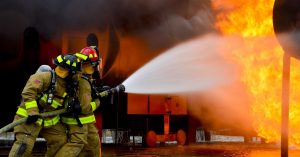
An industrial fire. Our regularly scheduled program halts due to massive pillars of smoke, red lights and sirens, and massive explosions. While they aren’t that common, they are a sight to see and leave rubble in their wake.
Significant accidents like the 2010 Kleen Energy Explosion (1) and the 1983 Newark Petroleum Explosion (2) are increasingly rare. The technology and lessons learned from those accidents, and many like them have improved both industrial fire prevention and suppression. However, programs, policies, and equipment are only as good as the employees who follow them, and the supervisors that enforce them.
Major fire incidents share practically the same few causes. Although, typically, carelessness and a lack of standards or rules create a situation where a fuel source is readily available, waiting for ignition. In the business of energy production, fuel sources are the name of the game. Coal dust, fuel oil, gas pipelines, and hydrogen cooling systems are just some of several available combustibles.
As for the ignition source, the NFPA sites Electrical Distribution and Heating Systems as their top two causes of industrial fires (3). A review of other industrial accidents reveals the next two most common themes: maintenance (welding, grinding, etc…) and not following procedures.
Believe it or not, the plant is probably the safest when it is operating. Engineered safety features and the somewhat routine activity of an operating plant is a low risk for fire. During plant operation, your biggest risk is an equipment failure. Catastrophic equipment failure is rare, as long as the people are operating and maintaining it the way they are supposed to, and when it does occur, it is typically contained easily and causes little damage. A recent battery fire at an NRG facility (4) is a perfect example. The safety systems were activated, and the Fire Department had little more to do than making sure they were working and help clean up the mess.

There is not much site personnel or management can do about the presence of combustible material and high voltage electrical equipment at a power generating station. However, advancements in automatic fire detection and suppression systems and automated industrial processes have reduced the human effect. Still, no amount of automation can ensure that flammable materials are properly stored, excessive combustible material is cleaned up, and safe maintenance and operating practices are performed properly. Perhaps the MOST dangerous time at a plant is when it is down for maintenance. Why? The beast is sleeping, and there are no dynamic conditions, all is quiet. In reality, systems are operating differently than normal; people are cutting, grinding and welding; tools and materials are stacked in places they wouldn’t usually be. Perhaps you’ve been swarmed with contractors, adding in another unknown.
Site personnel and management must be aware of the common causes and best practices for fire prevention. Inspections of operating areas, worksites, and hazardous material storage areas by management is a key component of ensuring the safety of the plant and people. Unquestionably, Cleanliness, proper storage, and organized maintenance practices will go a long way to prevent an expensive and potentially deadly accident.
Ensure plant personnel and contractors know the location and use of firefighting equipment and procedures. Furthermore, bring your local fire department(s) to the site on a routine basis, focusing on familiarizing them with your layout, hazard areas, and safety equipment. Finally, conduct a training exercise with your local fire departments. Your own employees can have a huge impact in the event of an actual emergency.
From a review of your procedures to a complete training program, Fossil Consulting Services is here to assist you in improving your operations. Well trained operators need accurate technical resources, and new operators need strong procedures to fill the gap in their experience. We can provide both. For more information, go to https://www.fossilconsulting.com/contact-us/.
References